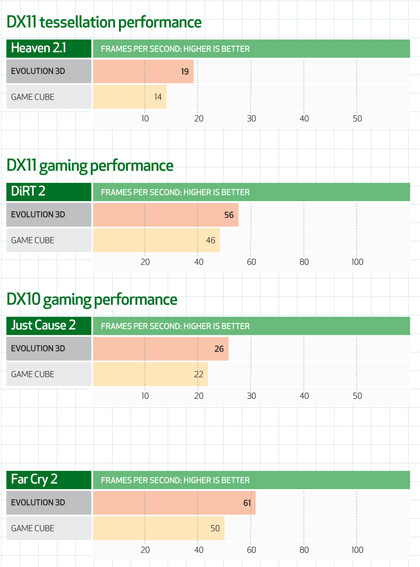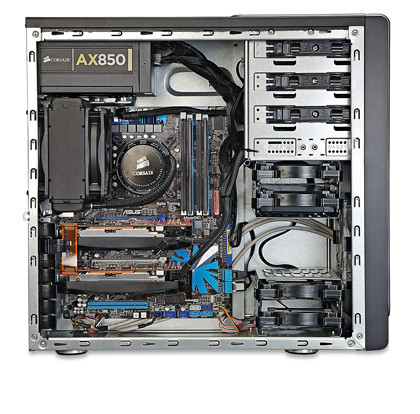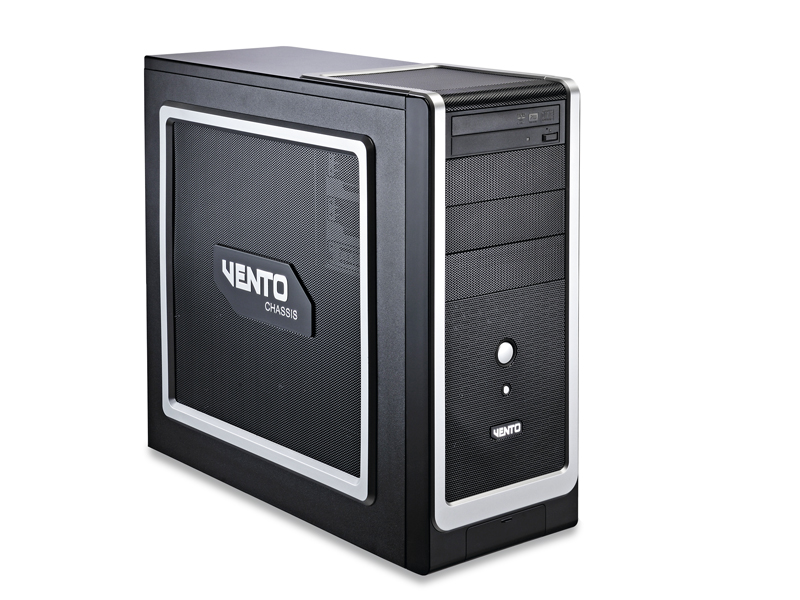TechRadar Verdict
Pros
- +
Incredible SLI performance
- +
Decent price
- +
Quality overclock and cooling
Cons
- -
Limited storage
Why you can trust TechRadar
The £1,000 price point is rapidly becoming the sweet spot for decent machines. With prices on key components dropping, and brand new parts arriving offering impressive performance for relatively inexpensive prices, the power available at this sweet spot just keeps growing and growing.
To the point where here we have a new machine, the Evolution 3D, from first-time PCFormat rig-builders the PCO Group, that's a quicker games machine than any other PC we've seen available at this price.
The key to the Evolution 3D's performance is a combination of an overclocked Intel Core i5 and a pair of Nvidia's latest GPU, the GTS 450. We checked out the GTS 450 last month, and a decent little card it turned out to be.
The first we saw was an overclocked version from Asus, and while it gave decent performance figures, it was still rather too close to the 768MB GTX 460 in terms of price. It also struggled to maintain a clear lead over its real competition, the HD 5770 from AMD.
A month later though, and thanks to price wars between AMD and Nvidia, and across the different distributors, you can now pick up a bog-standard GTS 450 for well under a ton. That's a proper Fermi GPU at a quite simply astonishing price – especially considering that this now puts it up against the HD 5750 in terms of price, and way ahead in terms of performance.
While that's great news for the gamer on a budget, it's also great news for anyone out there with an SLI-certified motherboard. And thanks to more and more mainstream mobos shipping with that functionality, that's a great deal of us.
You see, when you pair up two of these wee fellas in SLI they demonstrate exactly why multi-GPU machines are becoming more popular. SLI – and AMD's answer, CrossFire – now offer the sort of returns that we'd always hoped for. Check out our in-depth multi-GPU feature and you'll see what we mean.
In terms of decent PCs, that means we can now get the sort of performance out of a £1,000 rig that we'd have previously had to splash out maybe twice as much to get. Dual GPU machines are now where the smart money goes.
Everyone loves twins
Even just six months ago we'd have always said to just buy the fastest single graphics card your wallet could stretch to. The spectre of multi-GPU driver failures and the diminishing returns you used to get from adding a second, third or even fourth card meant that it was just not worth paying the extra pennies for the hassle it would give you.
Now, with two GTS 450s costing less than the price of an overclocked GTX 460 – and consistently out performing it by a long way while it's about it – it makes absolute sense to go for two. Not only have you got two GPUs working away on your game's frame rates, but you've also got double the single card's memory capacity. And when you're talking about big-screen gaming, or the drains memory-intensive effects such as anti-aliasing have on a system, that makes a hell of a difference.
The GTS 450 has been kitted out with a full 1GB of GDDR5, and when you've got the graphics pipes fed with a beefy 2GB of graphics memory you're laughing. So, on to the numbers then – and they make impressive reading.
The benchmarks



You wouldn't normally expect a £1,000 rig to be a decent accompaniment to a big-screen monitor, but the Evolution 3D's performance at the eye-popping 2,560 x 1,600 resolution is damned impressive. That's the 2GB of GDDR5 going to work right there.
In both DiRT 2 and Far Cry 2 the Evolution 3D was hitting 56 and 61fps respectively at the full 30-inch panel resolution. That's getting on for the sort of performance we've been used to from the full-fat Fermi card – the GTX 480 – and even then in overclocked trim.
Looking at the seriously GPU-stressing Just Cause 2, the 26fps score at 2,560 x 1,600 is likewise impressive. When you look at the system raper that is Metro 2033 though, you're starting to see the GF 106 GPU's limits when all the bells and whistles are switched into the 'on' mode. Still, the equally tessellation-heavy program, Heaven 2.1 Benchmark, came back with a score that's almost on a par with the GTX 460 in SLI confi guration.
All told that puts the twin GTS 450 setup ahead of almost every single GPU configuration out there, up to the GTX 480. That means that every other Fermi card must bow to this bargain setup, and AMD must be in one hell of a hurry to get its new lineup of graphics cards out of the stable door as soon as possible, because all of its GPUs are left in the dust by this pairing of two sub-£100 cards.
That's the graphics taken care of, but the new Core i5 760 is a welcome addition to the mix too. We already know how well this beauty overclocks in a decent P55 board, and the PCO Group has them running at 4GHz.
Cooked chips
Unfortunately though, our review unit turned out to be a little flaky at this clockspeed, only giving reliable results once the BCLK had been scaled back a couple of notches to 3.8GHz. That's not a massive issue though, as it's still faster than the CPU in the wee CyberPower Game Cube. And the PCO Group will guarantee the stability of your overclock too with a full 48-hour burn-in period carried out on every machine prior to shipping.
Unfortunately our review machine had a PSU failure during testing, and the time taken to fit and test the replacement meant there wasn't time for our rig's traditional burn-in. The PCO Group offers a free three-year collect and return warranty on its machines so in the event of an overclock not being stable you won't be out of pocket, and the maximum you'll be without your rig would be three working days.
We dropped in one of our own i5 760s, and with the BIOS settings PCO Group's tech team gave us we hit 4GHz without a problem, so it was definitely the CPU itself that was the problem and not the setup.
And with the new Corsair H70 closed-loop liquid cooler taken care of it, it's certainly not the heat stopping the previous CPU hitting the 4GHz mark. With that 1GHz+ boost in its stock clock frequencies, the i5 760 manages to provide impressive benchmark figures.
Looking at the Cinebench 11.5 index score, it's only just short of a standard Core i7 960 running at 3.2GHz, and that's a quad-core CPU with Intel's HyperThreading tech offering eight threads of processing power against the Core i5's four threads.
The other components propping up the Evolution 3D have obviously been picked with care too, hitting an almost perfect balance of power and affordability with a hint of future-proofing added for good measure.

The Asus P7P55D EVO motherboard was the obvious choice. Hitting a decent price with an SLI-certified mobo isn't easy, and this board is one of the few around for less than £150. Unfortunately, the price compromise has meant that there's neither of the new I/O interfaces available on this board, so there's no USB 3.0 or SATA 6Gbp/s.
Asus is prepping a new revision with both new I/O, smartly titled the P7P55D-E Deluxe, which is due to come in slightly cheaper. So if you definitely want both then it might be worth waiting before placing your order. That said though, add-on boards with SATA 6Gbp/s and USB 3.0 ports are not that expensive and don't offer any significant drop in performance over motherboard-based chips.
The future-proofing comes in the shape of the 850W Corsair PSU. That's more than enough to power this setup, and offers an upgrade path going forward. As you can see from our review of the 1200W model, the Corsair supplies are quality bits of kit.
Compact and bijou
My only real concern with the component spec of the Evolution 3D is the relative paucity of storage space. At 500GB it's not a great deal of capacity, especially once you start reinstalling your Steam back-catalogue, but it's not terrible.
Still, in a £1,000 rig these days you would expect that with terabyte drives being relatively inexpensive, that's the minimum.
I'm also not a massive fan of the Asus Vento chassis. I find the plastic tool-less design inside a little flimsy, and the clips holding down the PCI cards are not as solid as I'd like. But if the choice was ours and if we were trying to keep the spec to £1,000 we'd be sacrificing the chassis and the storage too. Hell, we'd build it in a shoe box if it meant we could keep this processor and SLI pairing.
This month we've got two machines around the £1,000 sweet spot: this SLI marvel and the teeny-tiny GTX 460 Game Cube from CyberPower. Both offer great performance in two different fields, and both would be a sound investment.
The Evolution 3D just has the edge in terms of performance. The twin GTS 450s have completely won us over in SLI trim, offering performance equivalent to the best Nvidia can offer for a long way short of the cost.
Aesthetically, it's not my bag, but my PC is always out of sight under the desk anyway. It's what goes on onscreen that counts for me, and the speed at which this rig flies has got us hooked. This is the fastest machine we've ever seen for £1,000. If that's your budget, this is your spec.
Follow TechRadar Reviews on Twitter: http://twitter.com/techradarreview
